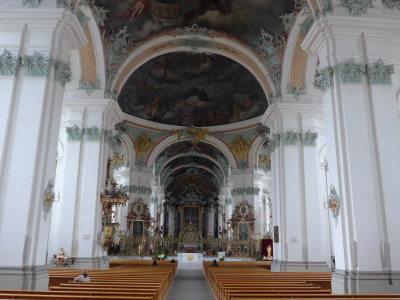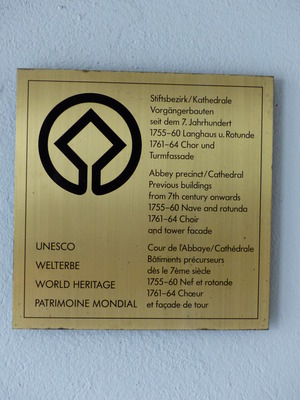Abbey of St Gall

The Abbey of St Gall had a great influence on the development of monastic architecture and is considered to be a typical example of a large Benedictine monastery.
It was during the abbacy of Gozbert (816-837) that the so-called Golden Age of St. Gall began. Most impressive remains of this period are the Convent's library and archive, containing 150.000 books including numerous treasures.
Community Perspective: The Library is the unmissable part, the Abbey’s exterior is quite plain.


Map of Abbey of St Gall
Community Reviews
Caspar Dechmann
This is a site with rather strange OUV which you can partially excuse or explain because it was such an early nomination:
Like the Reichenau this was one of the most important (and powerful) monasteries of medieval Europe with a great and widespread territory, one of the most important collections of manuscripts and books in the world and a famous writing workshop. It also lends its name to the most important architectural plan of the middle ages: the St. Gall monastery plan.
So far, so great. The problem is that not much of that contributes really its OUV: The church and the monastery nowadays are completely baroque and therefore not from the time when the monastery was at its peak but built far later. While this complex of buildings is grand and impressive it is in the whole not better or grander then a considerable number of great monasteries that were rebuilt in the baroque era, especially in southern Germany and Austria. The church has been restored a few years ago and I find the color scheme rather disturbing though it is supposed to refer to the original colors: While most ornaments have strange combination of turquoise and orange the large painting in the cupolas are still extremely dark like darkened by centuries of candle soot even after the restoration.
The only part that may have OUV as a building is the famous and wonderful library but even this has strong competition by a number similar baroque libraries, many of them also in monasteries. Some of the are inscribed like the great baroque libraries in Vienna and Prag. Of the medieval buildings are only two crypts left, as far as I now, and they are rarely open and difficult to visit and as far as I can tell from fotos they are simple structures.
The collection of books is still extremely important but is movable and should not contribute to the OUV.
The famous monastery plan is in the monastery museum and can be seen in the original. But it is certain that the plan was not drawn in St. Gallen but on the island of Reichenau! As a movable item it doesn't contribute to the physical OUV of the site in any case.
The larger part of the current complex is not accessible for the public: It is still a living monastery and in addition a school and a seat of government. Therefore you can basically visit the cathedral, the library and the basement with the museum. The latter has improved dramatically since a few years: It has been enlarged and you can visit the original monastery plan in a climatized room and there are good changing exhibitions (at least the one I saw was very good). Almost half of the complex is used by the cantonal government and I while I doubt they have real OUV they seem to include several interesting historicist rooms. As a WHS they should of course be accessible to the public but haven't been open for years, at least since I checked for tours. Fortunately I saw recently that now there seem to be regular tours on weekends and I planning to make use of that opportunity as soon as I have the chance.
In the whole, perhaps apart from the library, the monastery seems more inscribed for what it was at a time then for what you can see today, a fact that it shares, as a stated in the beginning, with the Reichenau monastery and several other sites. A visit is still interesting and worthwhile, not only for the library and the good museum but also for the beautiful old town around the monastery, famous for its magnificent oriels. Around the old town you find several splendid historicist and art nouveau buildings since St. Gall had world famous textil industry and very rich at the beginning of the 20th century. The central station seems the modern counterpiece to the baroque cathedral.
Philipp Peterer

After many years, thanks to a visit from Ian, I finally did a revisit of the abbey and its marvellous library. As mentioned in previous reviews, it is really the library the pulls this site out of mediocracy. We headed straight for the library of course. The ticket also includes the library, a museum in the basement and an exhibition room in another building. Pictures are not allowed in any of these rooms, but you really only want them from the library.
Entering the library still requires to put on slippers and there is always a knowledgeable employee present who can give you some details about the construction. A secret attraction is the mummy “Schepenese” in the far right corner. There are currently efforts by a local artist to bring the mummy back to Egypt. So visit, while she is still around.
The museum is ok, but nothing extraordinary. There is some information about Gallus, an Irish monk after whom St Gall is named. The exhibition room houses the world’s oldest monastery archive. This is actually interesting. There are documents about common problems of the time, including the separation of land between St Gall and nearby Constance.
We finished the visit in the church, which looks clearly better from the inside than the outside, before continuing to nearby Reichenau Monastic Island.
St Gall is quite a nice town, especially the monastic quarter around the abbey. While there, you should eat the St. Galler Bratwurst (eaten only with bread, no mustard allowed).
Clyde

I visited this WHS in June 2014. Having visited quite a number of monasteries and abbeys in Europe before, I wasn't impressed by the huge complex of churches, chapels, gardens, monastery buildings, etc. especially since they seemed to be relatively new or heavily restored and my first impression was "this is just another abbey like many other on the list". However, I left the Abbey Library for last and what a pleasant surprise it was. I spent at least 2 hours gazing at the pristine library full of old parchment books, an original mummy and a sarcophagus from the Hatsheput Temple in Egypt and a replica of a gorgeous globe (the original is housed in a museum in Zurich). For 12 euros, I got the entrance ticket with the very informative audio guide, wore special footwear over my shoes to protect the wooden floor and for most of the time I had the magnificent place to myself. That said, the number of visitors at a time can be around 100, so it's best to avoid weekends, public holidays or peak hours. I could have spent more time just gazing at the wonderful library as the only downside was that of getting a stiff neck! The library alone to me has OUV and is a jem everyone should behold!
Frederik Dawson

Since ancient time Sankt Gallen, the capital city of the canton of the same name, was well known for its magnificent abbey which was one of most important monastery in this region and was on my wish list to see for a long time. During my Switzerland tour, I took the Voralpen scenic train from Lucerne to Sankt Gallen, the scenery of pre-alpine region was really pretty and I highly recommended using this train as a mean of transportation to enter the city.
From the train station, it was very easy to reach the abbey by just walk along the lovely car free shopping street until you started to notice the huge complex on your right. The complex was very large with many buildings built encircled the cathedral. Actually I was quite disappointed with the complex's exterior, apart from the cathedral; these buildings were really plain with nothing significant to mention. The unbelievable greenish lawn and the two towers of the cathedral apse were the things to see. However for cathedral's interior, I was really impressed with the beautiful Rococo style and in my opinion, the green stucco decorating the naves were very unique as I had never seen this color in Rococo decoration before.
The monastic library was another highlight of this abbey, hiding in the very plain building both exterior and interior which made me not sure that I was in the correct place, but when I worn the big slippers, for protecting the wooden floor, and entered into the library, I was overwhelmed by the beauty of one of the most beautiful library in the world. The style of library was also Rococo with amazingly beautiful bookshelves and wonderful white stucco around the ceiling fresco, a real jewel of Switzerland. Sadly that photograph was not allowed.
I really enjoyed my day in Sankt Gallen, this city was a very nice place to visit, and the abbey was deserved to be a UNESCO World heritage Site. My only regret was that I had to cancel my plan to visit Richenau of Germany, another monastic WHS that claimed to have strong link with the abbey of Sankt Gallen due to the shopping street was very tempting with many local and international brands! But this maybe a good reason to revisit this area again in the near future!
Klaus Freisinger
When my flight to Malta and its 3 WHS was canceled because of the volcano, I made a nice train trip instead to St. Gall in Switzerland. It is a medium-sized town with a very pleasant centre full of historic buildings and half-timbered houses. The religious complex in the immediate city centre, consisting of the cathedral and the convent, is a World Heritage Site. Both buildings have a medieval (Carolingian) origin, but were heavily rebuilt in Baroque style. Both are quite nice, but the unmissable part is the library. You can actually only visit one room, but it is full of books and manuscripts that are up to 1,200 years old. A must-see for any history buff.
Assif
The greatest thing about St Gall is its old world-known library. It is of immense historic value and still contains unique manuscripts. Otherwise, the medieval monastery was heavily modified to suit the Baroque taste and the result I do not find that impressive.
Community Rating
- : George Gdanski Can SARICA Tamara Ratz Geo Thomas Harold Watson Zhenjun Liu Tony0001 JobStopar Rafał Kałczuga
- : Christoph Aspasia Dolemite92 Bropyk Daniel Gabi
- : SirLoydd Juropa Homadism Philipp Peterer Rickard Alfredsson Tarquinio_Superbo Subhayan_svnit WalGra Ih0000 MaxHeAnouBen Kevin247 Wimmy Gautamiyer23 Max Laurine Yevhen Ivanovych Wrung24
- : Wojciech Fedoruk Gary Arndt Craig Harder Westwards Christravelblog Cezar Grozavu Xiquinho Silva David Berlanda Lichia Chenboada Dimitrios Polychronopoulos Manuelfunk Ian Cade Fmaiolo@yahoo.com Dejulis@hotmail.com MH Aidan Coohill Tschibi Stanislaw Warwas
- : Els Slots Walter Svein Elias Zoë Sheng Dorejd Alexander Parsons Shandos Cleaver MoPython Adrian Turtschi Daniel C-Hazard Frederik Dawson Klaus Freisinger GerhardM Mahuhe CyBeRr Martina Rúčková Ralf Regele Kasper
- : Szucs Tamas Nan Randi Thomsen Stanimir Ivan Rucek Csaba Nováczky Jan Zimmermann Argo Nolan B. Tingmelvin João Aender Mo-han Je
- : Solivagant Clyde Philipp Leu CugelVance Caspar Dechmann VLabhard Assif Mohboh Roman Raab WILLIAM RICH
- : Alexander Lehmann Jean Lecaillon Hubert
Site Info
- Full Name
- Abbey of St Gall
- Unesco ID
- 268
- Country
- Switzerland
- Inscribed
- 1983
- Type
- Cultural
- Criteria
-
2 4
- Categories
- Religious structure - Christian
- Link
- By ID
Site History
2013 Name change
From "Convent of St. Gall" to "Abbey of St. Gall"
1983 Inscribed
Site Links
Unesco Website
Official Website
Connections
The site has 18 connections
Art and Architecture
Constructions
History
Human Activity
Religion and Belief
Science and Technology
Timeline
Trivia
Visiting conditions
WHS Hotspots
WHS Names
WHS on Other Lists
World Heritage Process
Visitors
331 Community Members have visited.
The Plaque
 (photo by Clyde)
(photo by Clyde)